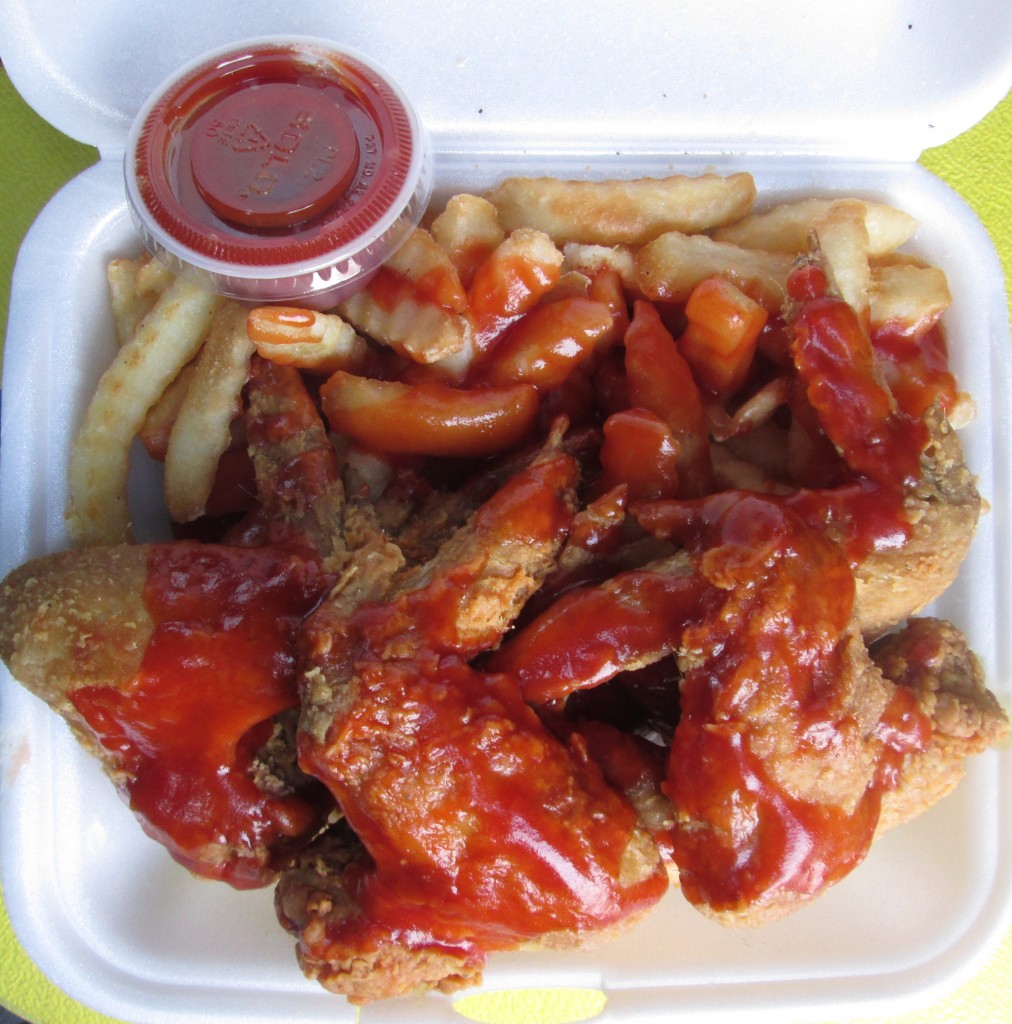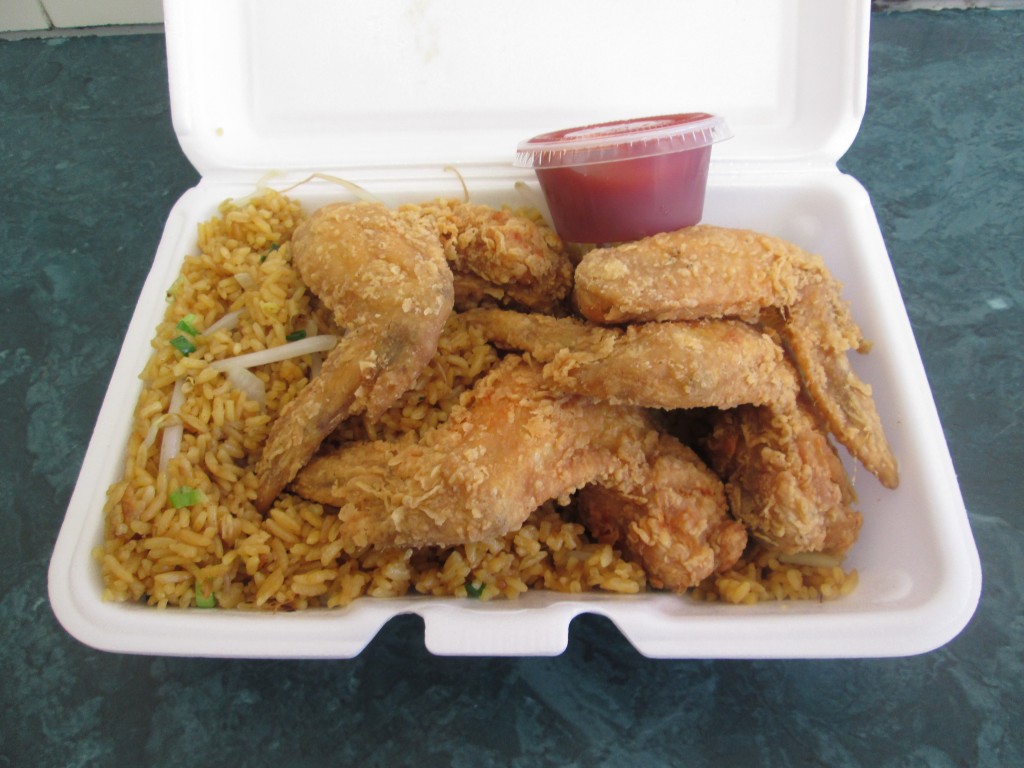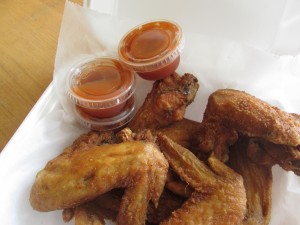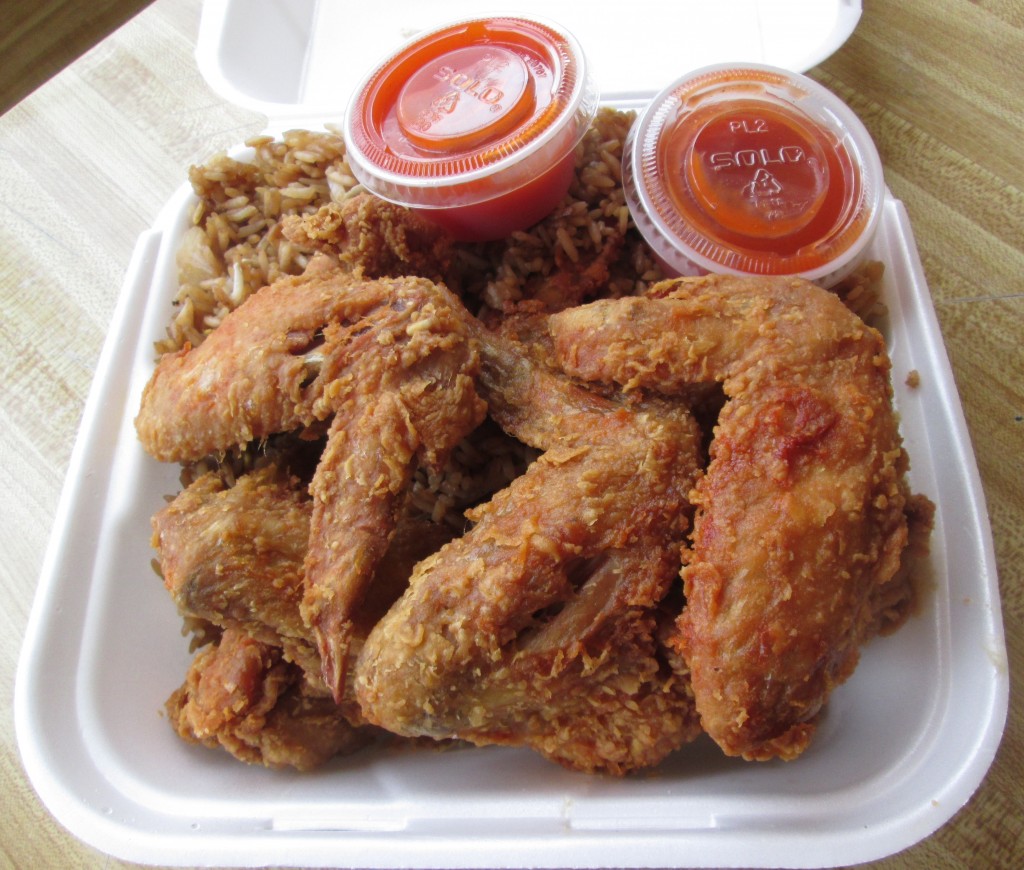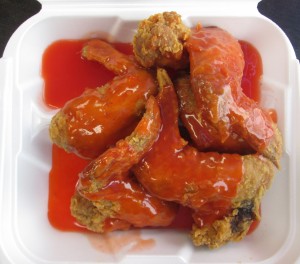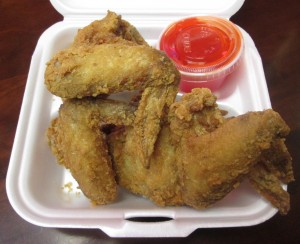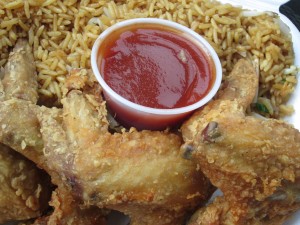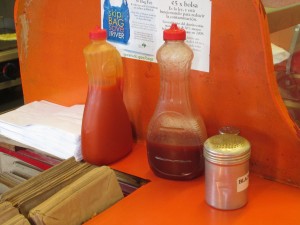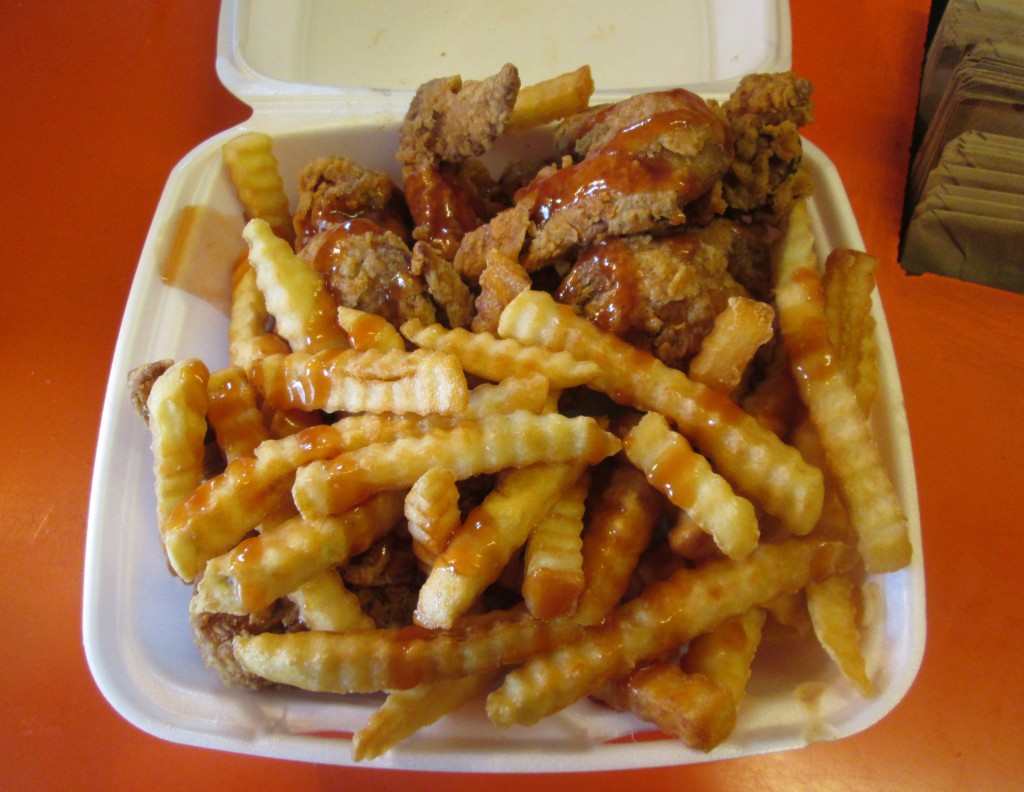(by Corbo Eng)
Do I wish it were different?┬ĀAs odd as it may sound, the answer is, ŌĆ£no.ŌĆØ┬ĀThese things are what they are.┬ĀWhen the cards were dealt, DC got what it got; and, whoŌĆÖs to complain, really?┬ĀSure, Baltimore has its crab cakes, Philly, its cheesesteaks, and New York, its pizza; but, DC has its mumbo sauce.┬ĀItŌĆÖs a less tangible thingŌĆönot like what other towns can boast. One isn’t hit with a big dose of proteins or carbs, for example. Nothing like that.┬ĀMumbo sauce is, after all, a sauce. It’s┬Āthe little sauce that couldŌĆöan unpretentious condiment that is DCŌĆÖs signature food.
It might sound crazy that this is so; but, anybody whoŌĆÖs from here or has ventured past the cityŌĆÖs trendiest neighborhoods to eat at the Chinese carryout joints that fill the cityŌĆÖs nooks and crannies knows just how popular mumbo sauce really is.┬ĀNo carryout shop is without it.┬ĀAnd, really, itŌĆÖs only when that layer of vaunted restaurants and hipster eateries is peeled back that one truly understands how ubiquitous Chinese carryout shops are in DCŌĆöand, as a corollary, how ubiquitous and integral mumbo sauce is in DCŌĆÖs food scene when that scene is considered in full.┬Ā ┬Ā┬Ā┬Ā
In the populist food culture that permeates DCŌĆÖs neighborhoodsŌĆöand, even, the immediate suburbs of Maryland and Virginia where Chinese carryout shops duly hold sway as wellŌĆöhomely foods like fried chicken wings are a staple; and, they are invariably served with mumbo sauce. Thin┬Āand vaguely viscous, mumbo sauce is a characteristically sweet, sometimes tangy, sometimes sour, sometimes spicy sauce that can be red, scarlet, amber, or any hue in between.
Mumbo sauce is offered in those clear plastic condiment cups that come with a snap-on lid; or, it can be simply slathered or drizzled directly onto the fried wings themselves (as well as the French fries or fried rice that frequently accompanies them).┬ĀItŌĆÖs a rite of passage that becomes habit and thatŌĆÖs as commonplace as ketchup or barbecue sauce in most other circles.┬ĀIn fact, mumbo sauce, as it is employed in DCŌĆÖs carryout shops, is a stand-in for those other condiments.┬ĀAnd, frankly, that’s ironic given that mumbo sauce, despite its many variations, is almost always made with ketchup as its base componentŌĆöwith barbecue sauce being a frequent partner in crime as well.
A survey of DCŌĆÖs mumbo sauces makes this readily apparent.┬ĀFor┬Āinstance, at DannyŌĆÖs, a local carryout chain with outposts in both DC and Maryland, the mumbo sauce is as such.┬ĀAt the Temple Hills location in Prince GeorgeŌĆÖs County, I ordered six wings and fries with mumbo sauce on top (and a side of it for good measure).┬ĀHere, the sauce has a pronounced ketchup-like taste.┬ĀIt’s essentially a barely transformed version of it with some extra vinegar boosting its force and a touch of hot sauce mixed in for some very faint heat.┬ĀThe mumbo sauce at YumŌĆÖs II, a popular Chinese carryout in the heart of DCŌĆÖs 14th Street corridor, is similar.┬ĀItŌĆÖs very much like ketchup but with bolstered notes of vinegar; and, like DannyŌĆÖs, the mumbo sauce is basically the same unmistakably characteristic reddish color of ketchup.┬ĀOn the surface, the two aforementioned iterations and ketchup are virtually indistinguishable.
HenryŌĆÖs Soul Caf├®, a soul food joint and chicken wing purveyorŌĆöone, unlike most in DC that is actually African-American ownedŌĆöfollows in this vein of offering mumbo sauce with a pronounced base.┬ĀHowever, unlike DannyŌĆÖs and YumŌĆÖs, the base isnŌĆÖt ketchup but, rather, barbecue sauce instead.┬ĀThe base flavor is, clearly, barbecue sauceŌĆöwhat kind, however, is hard to tell.┬ĀBut, itŌĆÖs obviously the foundationŌĆöwith ketchup and vinegar added in to assuage the primary flavor a bit.┬ĀItŌĆÖs good, more or less tangy, complements the fried wings well, and really demonstrates just how varied mumbo sauce can be as different versions of it promote and elevate either ketchup or barbecue sauce as the main constituent.
That said, mumbo sauce can deviate markedly from its base ketchup and barbecue sauce and taste mostly sweetŌĆöleaning in a direction that makes it less acidic and balanced and, in my mind, less appealing.┬ĀSuch versions are quite prevalent and are commonplace at Chinese carryouts throughout the city.┬ĀFor example, Howard China, a longstanding Chinese carryout on Georgia Ave. near Howard University, boasts a mumbo sauce that is primarily sweet in flavor.┬ĀIts color is a bit less red, and it teeters on the edge of being cloying.┬ĀItŌĆÖs much sweeter than the mumbo sauce found at DannyŌĆÖs or YumŌĆÖs.┬ĀThe sweetness, in fact, is interrupted only by a faint sour componentŌĆöa mild vinegar.┬ĀIn fact, the mumbo sauce, in its execution, could even be deemed ŌĆ£fruityŌĆØ (as if some kind of fruit juice or pur├®e were part of the equation).
Across the city limits, in Maryland againŌĆöthis time in Silver SpringŌĆöWing Wah Carryout is known for its mumbo sauce: one that is similar to Howard ChinaŌĆÖs in that itŌĆÖs more sweet than anything else.┬ĀIn fact, the sauce here is faintly ŌĆ£peachyŌĆØ in taste with hints of neutered ketchup thatŌĆÖs been thinned and arrested by other ingredients.┬ĀThis sweetening effect, however, is most pronounced at Panda Caf├® in Arlington, Virginia where the mumbo sauce that accompanied my order of wings tasted the most one note of any that I tried.┬ĀIt tasted sweet, of course; and, beyond that, there was seemingly nothing else.┬ĀIt was gloppy and, like the mumbo sauce at Wing Wah, a shade of neon red that reminded me of ketchup that had been mixed with something like corn syrup or agave nectar that could have given it its lightened and brightened overall appearance.
Of course, a mumbo sauce that is sweet and features less of a vinegary component is, consequently, less able to complement fried chicken wingsŌĆöwhich, as a consequence of being friedŌĆöcan be oily and in need of a bit of acid to subdue them.┬ĀBut, the best mumbo sauce acts as the perfect foil.┬ĀIt doesnŌĆÖt favor any one individual flavor at the expense of others.┬ĀOne such mumbo sauce is found at Full Yum, a Chinese carryout just south of New York Ave. on North Capitol Street. Here,┬Āan order of chicken wings is graced with a sweet, sour, mildly spicy mumbo accompaniment that is balanced in its approach and that enhances the wings.┬ĀMy teeth and gums, afterwards, didnŌĆÖt feel like they had been shot up with Novocain.
Such enhancement, to be sure, is most skillfully realized at SmokeyŌĆÖs in the 16th Street Heights neighborhood in DC. Aficionados of mumbo sauceŌĆöyes, theyŌĆÖre out thereŌĆöwill know this place well.┬ĀBoth SmokeyŌĆÖs and its owner, Eun Joo Angela Lee, were singled out in a Washington Post article in 2011 about mumbo sauce.┬ĀWhy all the fuss?┬ĀI wondered too; but, upon visiting SmokeyŌĆÖs, ordering the wings, fries, and, yes, smothering everything in mumbo sauce and tasting the food, itŌĆÖs clear that the sauce here is exceptional.
The sugar and vinegar complement one another perfectly; the result is something thatŌĆÖs just richly tangy in the best sense of the wordŌĆöwith barely perceptible notes of ketchup and barbecue sauce that are too well blended to disentangle.┬ĀThere’s just the right amount of faint sweetness to please the palate and just enough acid to cut through the oily residue of fried chicken wings without dominating them.┬ĀLee’s┬Āuse of a secret ingredientŌĆöginger powderŌĆöadds a bit of seductiveness too.┬ĀThe fact that the wings and friesŌĆöboth ultra crispyŌĆömight, very well, be the best in the city doesnŌĆÖt hurt either.┬ĀA meal at SmokeyŌĆÖs can leave one proud to call mumbo sauce DCŌĆÖs signature food.
Certainly, DCŌĆÖs little sauce that could is a unique calling cardŌĆösomething simple and homespun (if not homegrown). Of course, some food historians may gripe about and debate the true origins of mumbo sauceŌĆöabout how it actually originated in Chicago at a restaurant called Argia B.ŌĆÖs Bar-B-Q, which prominently sold something called ŌĆ£Mumbo Bar-B-Q SauceŌĆØ before mumbo sauceŌĆÖs supposed origins in DC in the 1960s (after ŌĆ£Mumbo Sauce,ŌĆØ capitalized as a proper noun, first appeared in Chicago).┬ĀBut, in my estimation, it doesnŌĆÖt really matter if the claim is true or not.┬ĀIt probably is.┬ĀEven if mumbo sauce didnŌĆÖt originate in DC, the fact of the matter is that itŌĆÖs become part of the food culture here.┬ĀIn the end, what matters most is not where somethingŌĆÖs from but where it takes root and grows.
And, in that regardŌĆöentrenched as it is in the everyday fabric of the city, in overlooked neighborhoods where tourists seldom, if ever, visit, embedded on the handwritten menuboards and folded takeout menus of easily dismissed Chinese carryout shops, and used as a condiment for cheap proletarian fried chicken wingsŌĆöthere is no humbler culinary ambassador for any city than mumbo sauce.┬ĀFor me, thatŌĆÖs appealingŌĆöbecause any worthy signature food item shouldnŌĆÖt be the purview of high end restaurants or something, for example, that DCŌĆÖs power brokers could have had a hand in shaping.┬ĀIndeed, a signature food should be of the people, by the people, and for the people.┬ĀIn the case of mumbo sauce, itŌĆÖs true.┬ĀHow appropriate is that for a city like Washington, DC?┬Ā┬Ā┬Ā
┬Ā
Copyright 2014 (Corbo Eng).┬Ā All rights reserved.
All photos by Corbo Eng.
┬Ā

